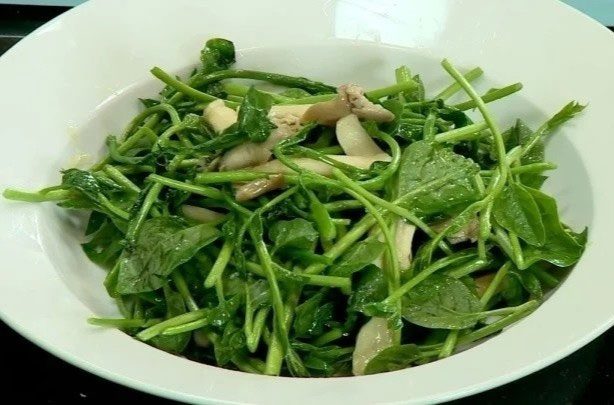Malabar spinach, known for its numerous health benefits, has long been recognized as a vegetable that helps prevent various ailments. However, it is only beneficial if consumed in moderation and the right way.
For some individuals, overindulgence in malabar spinach can exacerbate health issues. Below are the potential harms of malabar spinach when consumed improperly.
Health Benefits of Malabar Spinach
Detoxification, Relief from Constipation
Take a handful of malabar spinach leaves, wash them thoroughly, and crush them to extract the juice. Mix the juice with a little boiled and cooled water to drink at once. After a few doses, bowel movements will become easier. Alternatively, use 500 grams of malabar spinach, add fish sauce, salt, and cook it into a soup for daily meals. After a few days, you will notice relief from constipation.
Rich in Vitamin A
The recommended daily intake of vitamin A is 2,310 IU for women and 3,000 IU for men. With 510 IU of vitamin A per serving, malabar spinach is an excellent way to reach your daily intake.
Furthermore, vitamin A is crucial for the immune system, assisting in the production of white blood cells to fend off bacteria and viruses. The functioning of the reproductive system, bones, and vision also relies on an adequate amount of vitamin A.

High calcium content in malabar spinach helps strengthen bones and teeth.
Prevention of Osteoporosis
The high calcium content in malabar spinach helps maintain strong bones and teeth, improves muscle function, the nervous system, and hormone balance in the body, thereby reducing the risk of osteoporosis.
Most adults need to supplement approximately 1,000-1,200 mg of calcium daily, while malabar spinach can provide about 55 mg of calcium in a small serving.
Beneficial for Pregnant and Nursing Women
Folic acid is one of the essential B vitamins for pregnant women, as it helps prevent congenital neural tube defects such as spina bifida. It also plays a role in the creation of new cells, boosts cardiovascular health, and helps prevent cancer.
Iron is another nutrient found in malabar spinach that is very beneficial for pregnant women. A small serving of malabar spinach contains about 0.98 mg of iron, providing 5.4-12% of the daily required iron intake.
Who Should Avoid Malabar Spinach?
Individuals with Diarrhea or Loose Stools
Traditionally, malabar spinach is used as a cooling vegetable that adds fluids, preventing dryness and constipation due to its cooling and laxative properties. However, because of these characteristics, individuals experiencing diarrhea or loose stools should avoid it. Consuming it can worsen their condition.
Malabar spinach can easily create plaque on teeth because the oxalic acid in the vegetable is not water-soluble. Therefore, those who have recently undergone dental cleaning should avoid malabar spinach for 1-2 weeks.
Individuals with Kidney Stones
Malabar spinach contains a high level of purine, an organic compound that, when metabolized, converts to uric acid, increasing the risk of developing kidney stones. The oxalic acids present in malabar spinach raise the concentration of calcium oxalate in urine, leading to the growth of kidney stones.
Thus, individuals with kidney stones should refrain from eating malabar spinach.

Malabar spinach is very beneficial, but not everyone can eat it. (Photo: VTC).
Individuals Who Have Recently Had Dental Cleaning
Malabar spinach can easily create plaque buildup on teeth, due to the presence of oxalic acid that is not water-soluble.
Therefore, those who have recently had dental cleaning should avoid malabar spinach for 1-2 weeks.
Safe malabar spinach usually has a slightly yellowish-green color, not the vibrant dark green seen in chemically treated vegetables. The leaves are short and thick, growing proportionately to the stem. The stem is crunchy and firm, not glossy like plants treated with growth stimulants.
Individuals with Stomach Pain
Malabar spinach has a high fiber content; one cup of cooked malabar spinach contains about 6g of fiber. While fiber is essential for promoting digestion, consuming too much at once can cause stomach discomfort.
Because of this characteristic, individuals with a weak stomach or experiencing diarrhea should limit their intake. If they insist on consuming malabar spinach, their condition may worsen.
Important Considerations When Eating Malabar Spinach
Safe malabar spinach typically has a slightly yellowish-green color rather than the vibrant dark green associated with chemically treated vegetables. The leaves are short, thick, and proportionate to the stem. The stem is crunchy and firm, not glossy like plants treated with growth stimulants.
When combined with beef, malabar spinach loses its laxative properties and is harder to digest. Those suffering from constipation should avoid pairing these two foods, as it can worsen their condition.
Cooked malabar spinach should be consumed in its entirety; leftovers should be discarded rather than saved for later, as they can easily cause poisoning.


















































